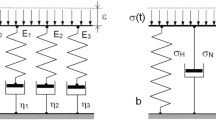Abstract
Changes in the stress relaxation behavior of Cheddar cheese was measured at different storage temperatures (5-25ºC). A 3-element Maxwell model was used for calculation of instantaneous elastic, elastic, and viscous constants. As the storage temperature increased from 5 to 25ºC, rheological properties of instantaneous and equilibrium stresses, and instantaneous elastic, elastic, and viscous constants decreased. A master curve was constructed based on moving each stress relaxation curve horizontally on the basis of reference temperature (15ºC) with shift factors. The master curve of Cheddar cheese had a linear temperature dependency. The modulus of elasticity decreased as the storage temperature increased. The predicted shelf life and activation energy of Cheddar cheese at different storage temperatures were calculated using the Williams-Landel-Ferry equation. The activation energy was 50.25 kcal/mol, and the expected shelf life was 15 times longer when stored at 5ºC than at 15ºC.
Similar content being viewed by others
References
Yoon SS. Research trends and future directions for R&D vitalization of domestic dairy industry. Korean J. Dairy Sci. Technol. 29: 23–31 (2011)
Ahn SI, Choi KH, Kwak HS. Development of functionality in cheese. Korean J. Dairy Sci. Technol. 29: 65–73 (2011)
Lee YJ, Yang HJ, Chun SS. Development of sulgidduk with Queso blanco cheese. J. Korean Soc. Food. Sci. Nutr. 40: 575–580 (2011)
Peleg M. Characterization of the stress relaxation curves of solid foods. J. Food Sci. 44: 277–281 (1979)
Rosenberg M, Wang Z, Chuang SL, Shoemaker CF. Viscoelastic property changes in Cheddar cheese during ripening. J. Food Sci. 640–644 (1995)
Tunick MH. Activation energy measurements in rheological analysis of cheese. Int. Dairy J. 20: 680–685 (2010)
Kim BY, Kim MH. Studies on the rheological models and properties of fish protein gel by process conditions. Food Eng. Prog. 2: 197–203 (1998)
Herum FL, Mensah JK, Barre HJ, Majidzadeh K. Viscoelastic behavior of soybeans due to temperature and moisture content. T. ASAE 22: 1219–1224 (1979)
Pappas G, Rao VNM. Effects of temperature and moisture content on the viscoelastic behavior of cowpeas. J. Texture Stud. 20: 393–407 (1989)
Jin IH, Lee SP. Physicochemical and rheological evaluation of ricewhole soybean curds prepared by microbial transglutaminase. J. Korean Soc. Food Sci. Nutr. 40: 738–746 (2011)
Choi HD, Seog HM, Kim YS, Lee CH. Effect of barley ß-glucan on dynamic viscoelasticity of barley starch. Korean J. Food Sci. Technol. 35: 1022–1027 (2003)
Grinberg NV, Bikbov TM, Grinberg VY, Tolstoguzov VB. Thermotropic gelation of ovalbumin 1. Viscoelastic properties of gels as a function of heating conditions and protein concentration at various pH values. Colloid Polym. Sci. 266: 52–59 (1988)
Katsuta K, Rector D, Kinsella JE. Viscoelastic properties of whey protein gels-Mechanical model and effects of protein concentration on creep. J. Food Sci. 55: 516–521 (1990)
AOAC. Official Method of Analysis of AOAC Intl. 18th ed. Method 955.04. Association of Official Analytical Chemists, Gaithersburg, MD, USA (2005)
Avalli A, Contarini G. Determination of phospholipids in dairy products by SPE/HPLC/ELSD. J. Chromatogr. A 1071: 185–190 (2005)
Bueche F. Physical Properties of Polymers. Krieger Press, NY, USA. p. 144 (1979)
Jang WY, Kim BY, Kim MH. Prediction of the rheological of soybean curd during storage by using WLF equation. Korean J. Food Sci.Technol. 27: 193–198 (1995)
Drake MA, Boylston TD, Swanson BG. Fat mimetics in low-fat Cheddar cheese. J. Food Sci. 61: 1267–1271 (1996)
Trepanier G, Abboudi MEL, Lee BH, Simard RE. Accelerated maturation of Cheddar cheese: Influence of added lactobacilli and commercial protease on composition and texture. J. Food Sci. 57: 898–902 (1992)
Zoon P, Roefs SPFM, de Cindio B, Van Vliet T. Rheological properties of skim milk gels at various temperatures; Interrelation between the dynamic moduli and the relaxation modulus. Rheol. Acta 29: 223–230 (1990)
Ak MM, Gunasekaran S. Evaluating rheological properties of Mozzarella cheese by the squeezing flow method. J. Texture Stud. 26: 695–712 (1996)
Del Nobile MA, Chillo S, Mentana A, Baiano A. Use of the generalized Maxwell model for describing the stress relaxation behavior of solid-like foods. J. Food Eng. 78: 978–983 (2007)
Katsuta K, Kinsella JE. Effects of temperature of viscoelastic properties and activation energies of whey protein gels. J. Food Sci. 55: 1296–1302 (1990)
Yoon WB, Park JW, Kim BY, Kim MH. Dynamic properties of surimi-based seafood product as a function of moisture content. Food Eng. Prog. 2: 23–29 (1998)
Hsieh YL, Yun JJ, Rao MA. Rheological Properties of Mozzarella cheese filled with dairy, egg, soy proteins, and gelatin. J. Food Sci. 58: 1001–1004 (1993)
Author information
Authors and Affiliations
Corresponding author
Rights and permissions
About this article
Cite this article
Kim, JY., Lee, KB., Shin, YK. et al. Changes in the rheological properties of cheddar cheese at different storage temperatures. Food Sci Biotechnol 24, 1349–1353 (2015). https://doi.org/10.1007/s10068-015-0173-1
Received:
Revised:
Accepted:
Published:
Issue Date:
DOI: https://doi.org/10.1007/s10068-015-0173-1




